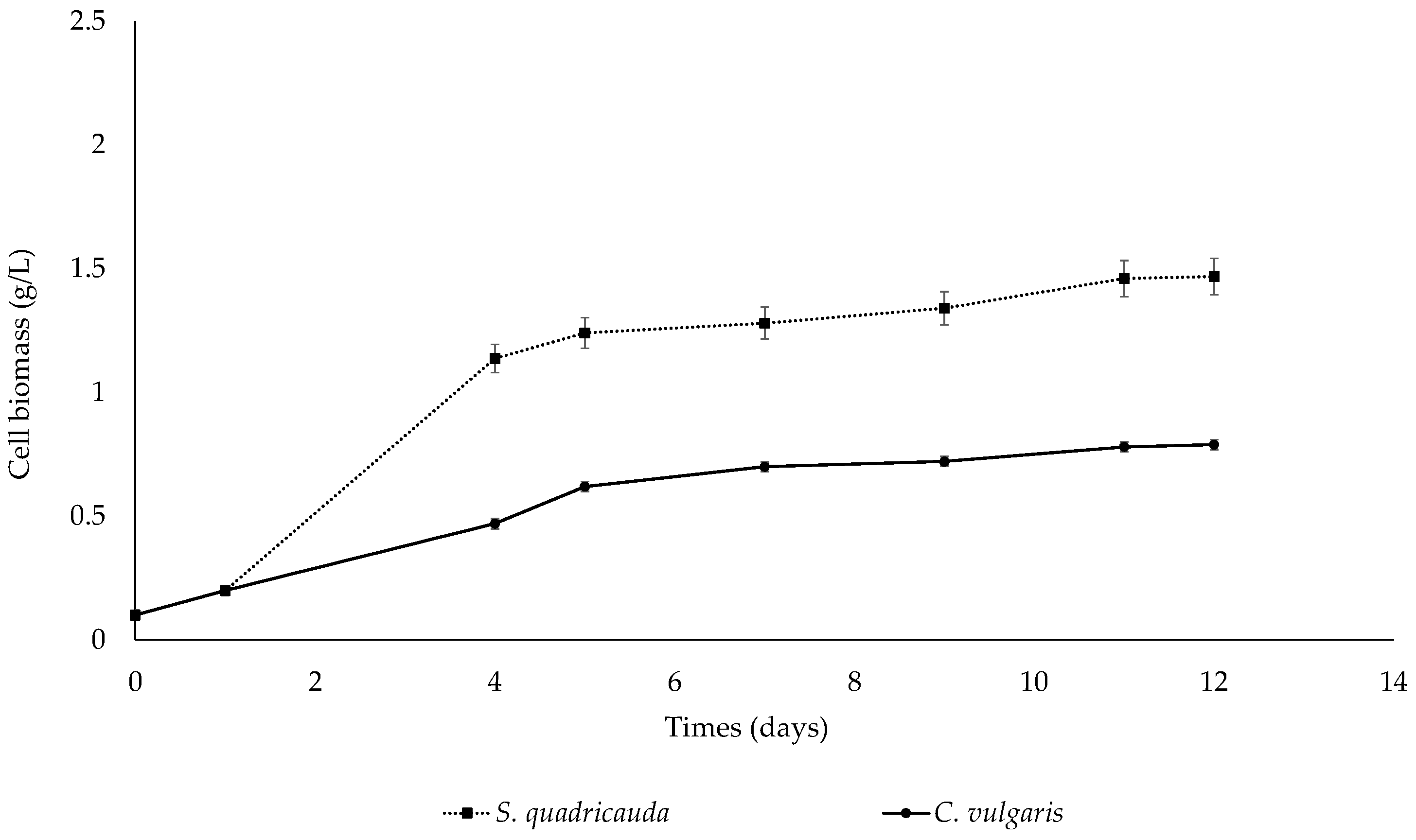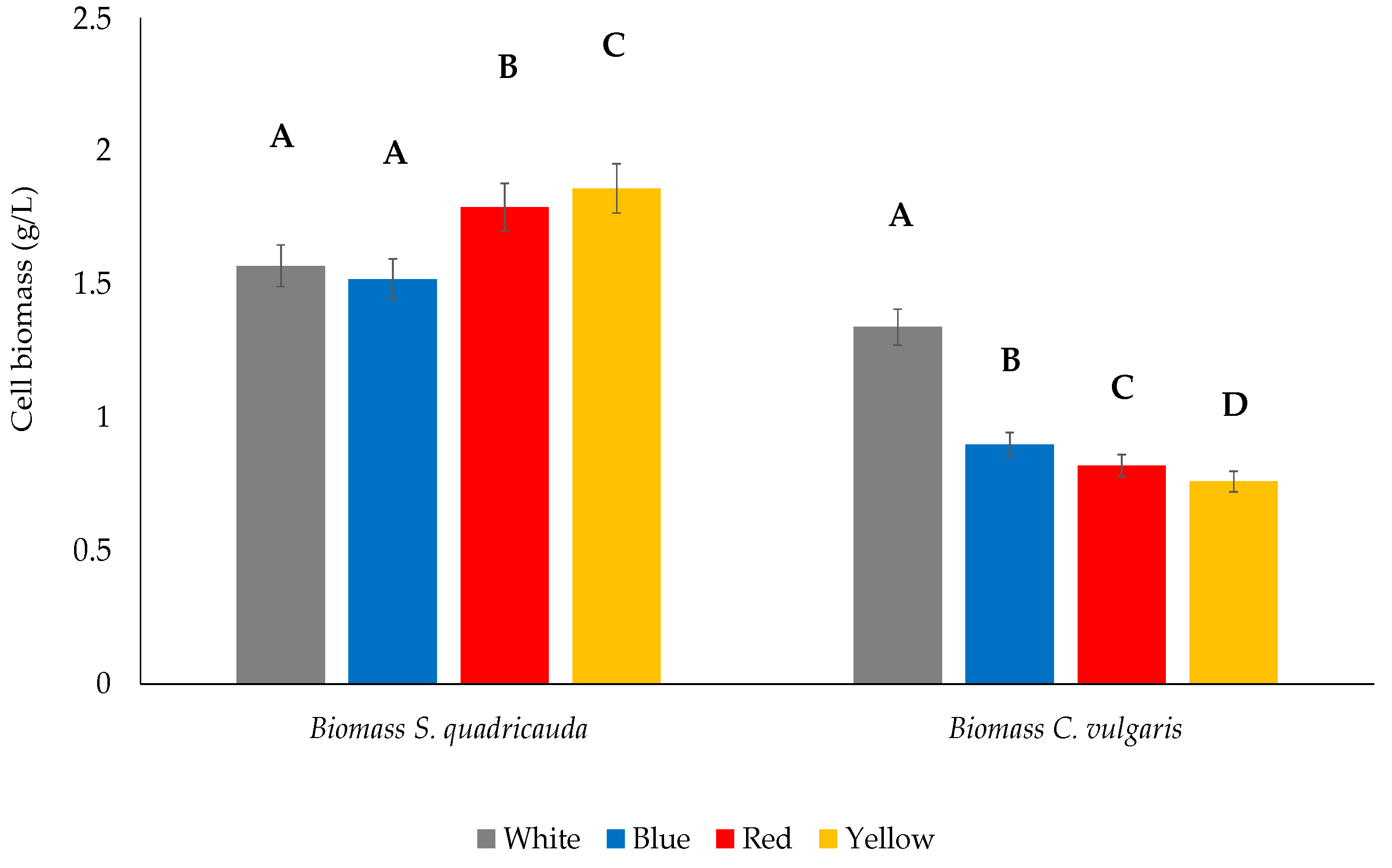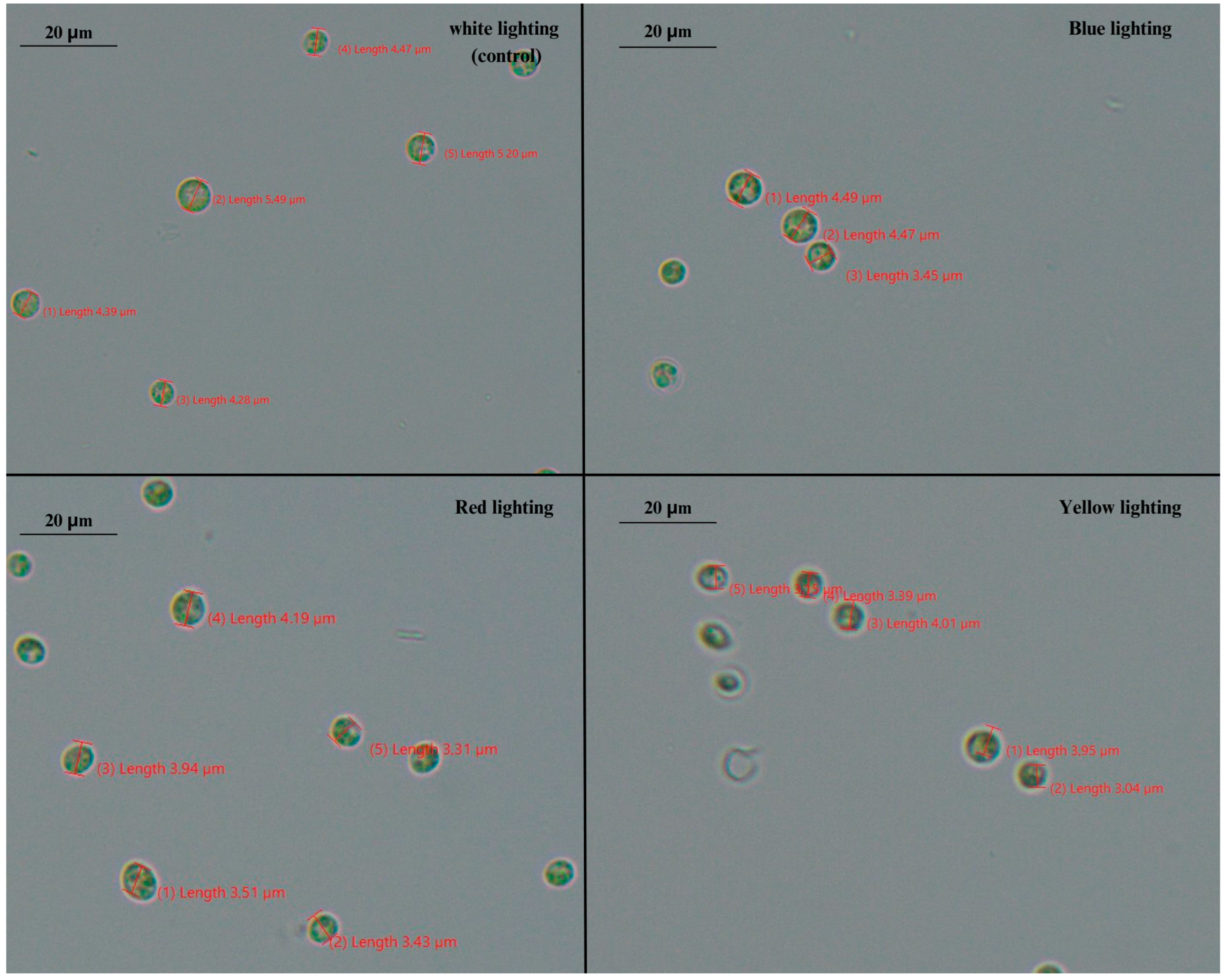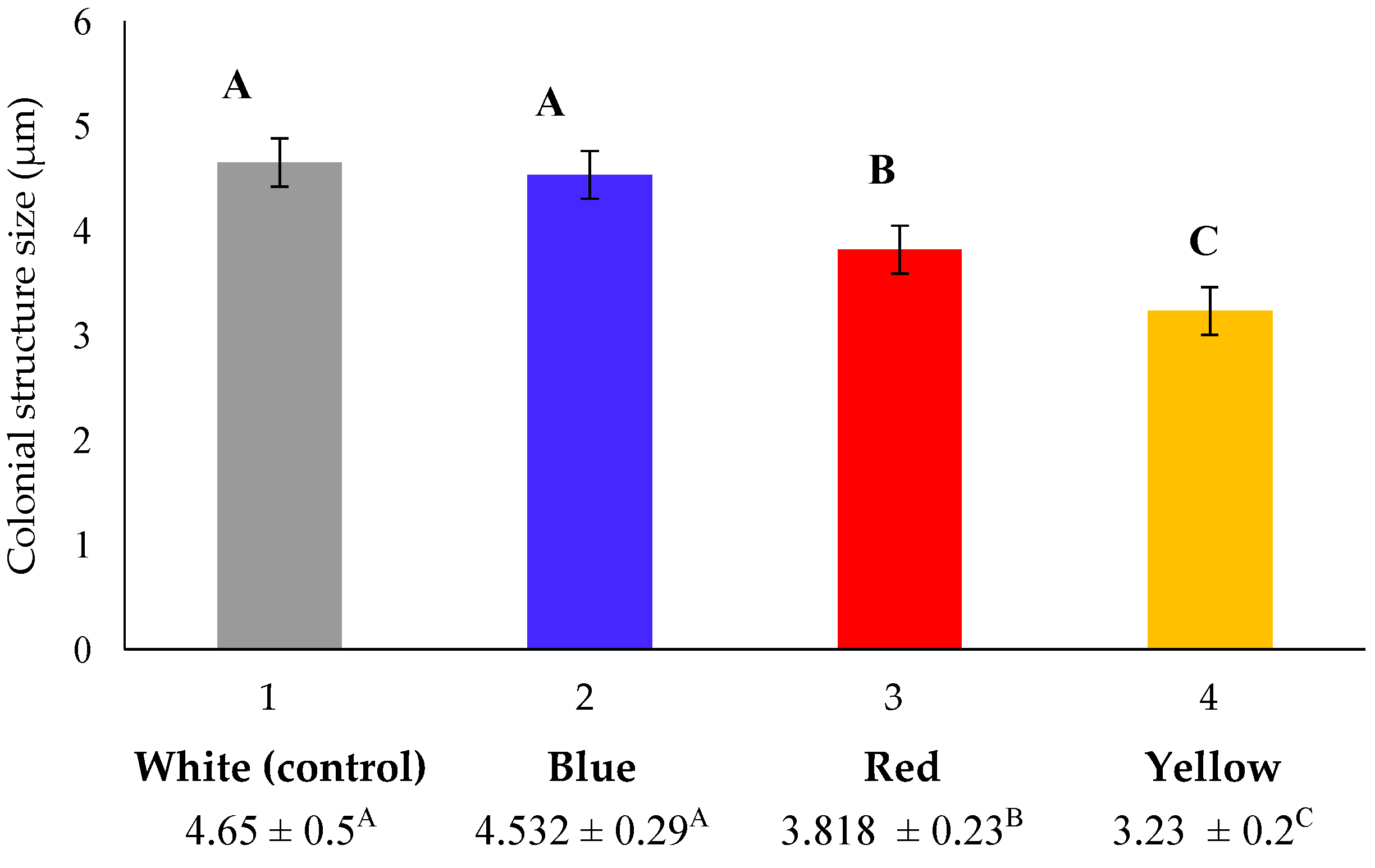Evaluation of Growth and Production of High-Value-Added Metabolites in Scenedesmus quadricauda and Chlorella vulgaris Grown on Crude Glycerol under Heterotrophic and Mixotrophic Conditions Using Monochromatic Light-Emitting Diodes (LEDs)
Abstract
:1. Introduction
2. Materials and Methods
2.1. Microorganisms and Culture Conditions
2.2. Evaluation of Cells Morphology
2.3. Analytical Methods
2.4. Calculations
2.5. Statistical Analysis
3. Results
3.1. Growth of S. quadricauda and C. vulgaris on Crude Glycerol under Heterotrophic and Mixotrophic Conditions
3.1.1. Heterotrophic Conditions
3.1.2. Mixotrophic Conditions
3.2. Biochemical Composition of the Microalgal Cells
3.2.1. Heterotrophic Conditions
3.2.2. Mixotrophic Conditions
3.3. Morphological Observations of the Cells
3.3.1. Phenotype of S. quadricauda under Heterotrophic and Mixotrophic Conditions
3.3.2. Phenotype of C. vulgaris under Mixotrophic Conditions
4. Discussion
5. Conclusions
Author Contributions
Funding
Data Availability Statement
Conflicts of Interest
References
- Shafiee, S.; Topal, E. A long-term view of worldwide fossil fuel prices. Appl. Energy 2010, 87, 988–1000. [Google Scholar] [CrossRef]
- Pulz, O.; Grass, W. Valuable products from biotechnology of microalgae. Appl. Microbiol. Biotechnol. 2004, 65, 635–648. [Google Scholar] [CrossRef]
- Spolaore, P.; Joannis-Cassan, C.; Duran, E.; Isambert, A. Commercial applications of microalgae. J. Biosci. Bioeng. 2006, 10, 87–96. [Google Scholar] [CrossRef] [PubMed]
- Karnaouri, A.; Chalima, A.; Kalogiannis, K.G.; Varamogianni-Mamatsi, D.; Lappas, A.; Topakas, E. Utilization of lignocellulosic biomass towards the production of omega-3 fatty acids by the heterotrophic marine microalga Crypthecodinium cohnii. Bioresour. Technol. 2020, 303, 122899. [Google Scholar] [CrossRef] [PubMed]
- Fernández, F.G.A.; Reis, A.; Wijffels, R.H.; Barbosa, M.; Verdelho, V.; Llamas, B. The role of microalgae in the bioeconomy. New Biotechnol. 2021, 61, 99–107. [Google Scholar] [CrossRef]
- Pang, N.; Gu, X.; Chen, S.; Kirchhoff, H.; Lei, H.; Roje, S. Exploiting mixotrophy for improving productivities of biomass and co-products of microalgae. Renew. Sustain. Energy Rev. 2019, 112, 450–460. [Google Scholar] [CrossRef]
- Choi, H.-J.; Yu, S.-W. Influence of crude glycerol on the biomass and lipid content of microalgae. Biotechnol. Biotechnol. Equip. 2015, 29, 506–513. [Google Scholar] [CrossRef]
- Markou, G. Effect of various colors of light-emitting diodes (LEDs) on the biomass composition of Arthrospira platensis cultivated in semi-continuous mode. Appl. Biochem. Biotechnol. 2014, 172, 2758–2768. [Google Scholar] [CrossRef]
- Wang, C.Y.; Fu, C.C.; Liu, Y.C. Effects of using light-emitting diodes on the cultivation of Spirulina platensis. Biochem. Eng. J. 2007, 37, 21–25. [Google Scholar] [CrossRef]
- Fu, W.; Guðmundsson, Ó.; Paglia, G.; Herjólfsson, G.; Andrésson, Ó.S.; Palsson, B.Ø.; Brynjólfsson, S. Enhancement of carotenoid biosynthesis in the green microalga Dunaliella salina with light-emitting diodes and adaptive laboratory evolution. Appl. Microbiol. Biotechnol. 2012, 97, 2395–2403. [Google Scholar] [CrossRef] [PubMed]
- Chen, C.Y.; Chen, Y.C.; Huang, H.C.; Huang, C.C.; Lee, W.L.; Chang, J.S. Engineering strategies for enhancing the production of eicosapentaenoic acid (EPA) from an isolated microalga Nannochloropsis oceanica CY2. Bioresour. Technol. 2013, 147, 160–167. [Google Scholar] [CrossRef] [PubMed]
- Shu, C.H.; Tsai, C.C.; Liao, W.H.; Chen, K.Y.; Huang, H.C. Effects of light quality on the accumulation of oil in a mixed culture of Chlorella sp. and Saccharomyces cerevisiae. J. Chem. Technol. Biotechnol. 2011, 87, 601–607. [Google Scholar] [CrossRef]
- Perin, G.; Gambaro, F.; Morosinotto, T. Knowledge of regulation of photosynthesis in outdoor microalgae cultures is essential for the optimization of biomass productivity. Front. Plant Sci. 2022, 13, 846496. [Google Scholar] [CrossRef] [PubMed]
- da Silva, M.E.T.; Martins, M.A.; de Oliveira Leite, M.; Leite Milião, G.; dos Reis Coimbra, J.S. Extraction of pigments and fatty acids from the green alga Scenedesmus obliquus (Chlorophyceae). Aquat. Ecol. 2021, 34, 119–126. [Google Scholar]
- Schulze, P.S.; Barreira, L.A.; Pereira, H.G.; Perales, J.A.; Varela, J.C. Light emitting diodes (LEDs) applied to microalgal production. Trends Biotechnol. 2014, 32, 422–430. [Google Scholar] [CrossRef]
- Ra, C.H.; Kang, C.H.; Jung, J.H.; Jeong, G.T.; Kim, S.K. Effects of light-emitting diodes (LEDs) on the accumulation of lipid content using a two-phase culture process with three microalgae. Bioresour. Technol. 2016, 212, 254–261. [Google Scholar] [CrossRef]
- Schüler, L.; Trovão, M.; Machado, A.; Carvalho, B.; Carneiro, M.; Maia, I.; Soares, M.; Duarte, P.; Barros, A.; Pereira, H.; et al. Isolation and characterization of novel Chlorella vulgaris mutants with low chlorophyll and improved protein contents for food applications. Front. Bioeng. Biotechnol. 2020, 8, 469. [Google Scholar] [CrossRef]
- Lakshmidevi, R.; Gandhi, N.N.; Muthukumar, K. Enhanced biomass and lutein production by mixotrophic cultivation of Scenedesmus sp. using crude glycerol in an airlift photobioreactor. Biochem. Eng. J. 2020, 161, 107684. [Google Scholar]
- Xu, S.; Elsayed, M.; Ismail, G.A.; Li, C.; Wang, S.; Abomohra, A.E. Evaluation of bioethanol and biodiesel production from Scenedesmus obliquus grown in biodiesel waste glycerol: A sequential integrated route for enhanced energy recovery. Energy Convers. Manag. 2019, 197, 111907. [Google Scholar] [CrossRef]
- Abomohra, A.E.; Eladel, H.; El-Esawi, M.; Wang, S.; Wang, Q.; He, Z.; Feng, Y.; Shang, H.; Hanelt, D. Effect of lipid-free microalgal biomass and waste glycerol on growth and lipid production of Scenedesmus obliquus: Innovative waste recycling for extraordinary lipid production. Bioresour. Technol. 2018, 249, 992–999. [Google Scholar] [CrossRef]
- Sun, Y.; Liu, J.; Xie, T.; Xiong, X.; Liu, W.; Liang, B.; Zhang, Y. Enhanced lipid accumulation by Chlorella vulgaris in a two-stage fed-batch culture with glycerol. Energy Fuels 2014, 28, 3172–3177. [Google Scholar] [CrossRef]
- Andruleviciute, V.; Makareviciene, V.; Skorupskaite, V.; Gumbyte, M. Biomass and oil content of Chlorella sp., Haematococcus sp., Nannochloris sp. and Scenedesmus sp. under mixotrophic growth conditions in the presence of technical glycerol. J. Appl. Phycol. 2014, 26, 83–90. [Google Scholar] [CrossRef]
- Ma, X.; Zheng, H.; Addy, M.; Anderson, E.; Liu, Y.; Chen, P.; Ruan, R. Cultivation of Chlorella vulgaris in wastewater with waste glycerol: Strategies for improving nutrients removal and enhancing lipid production. Bioresour. Technol. 2016, 207, 252–261. [Google Scholar] [CrossRef]
- Zhao, G.; Yu, J.; Jiang, F.; Zhnag, X.; Tan, T. The effect of different trophic modes on lipid accumulation of Scenedesmus quadricauda. Bioresour. Technol. 2012, 114, 466–471. [Google Scholar] [CrossRef] [PubMed]
- Izard, J.; Limberger, R.J. Rapid screening method for quantitation of bacterial cell lipids from whole cells. Microbiol. Methods 2003, 55, 411–418. [Google Scholar] [CrossRef] [PubMed]
- Kochert, G. Carbohydrate determination by phenol-sulfuric acid method. In Handbook of Phycological Methods. Physiological and Biochemical Methods; Hellebust, J.A., Craige, J.S., Eds.; Cambridge University Press: London, UK, 1978; pp. 95–97. [Google Scholar]
- Lowry, O.H.; Rosebrough, N.J.; Farr, A.L.; Randall, R.J. Protein measurement with the Folin phenol reagent. J. Biol. Chem. 1951, 193, 265–275. [Google Scholar] [CrossRef]
- Lichtenthaler, H.K. Chlorophylls and carotenoids: Pigments of photosynthetic biomembranes. Methods Enzymol. 1987, 148, 350–382. [Google Scholar]
- Ferro, L.; Gojkovic, Z.; Gorzas, A.; Funk, C. Statistical methods for rapid quantification of proteins, lipids, and carbohydrates in Nordic microalgal species using ATR-FTIR spectroscopy. Molecules 2019, 24, 3237. [Google Scholar] [CrossRef]
- Arguelles, E.D.; Laurena, A.C.; Monsalud, R.G.; Martinez-Goss, M.R. Fatty acid profile and fuel-derived physico-chemical properties of biodiesel obtained from an indigenous green microalga, Desmodesmus sp. (I-AU1), as potential source of renewable lipid and high-quality biodiesel. J. Appl. Phycol. 2018, 30, 411–419. [Google Scholar] [CrossRef]
- Perez-Garcia, O.; Escalante, F.M.E.; de-Bashan, L.E.; Bashan, Y. Heterotrophic cultures of microalgae: Metabolism and potential products. Water Res. 2011, 45, 11–36. [Google Scholar] [CrossRef]
- Sutherland, D.; Ralph, P. Differing growth responses in four related microalgal genera grown under autotrophic, mixotrophic and heterotrophic conditions. J. Appl. Phycol. 2021, 33, 3539–3553. [Google Scholar] [CrossRef]
- Hu, J.; Nagarajan, D.; Zhang, Q.; Chang, J.S.; Lee, D.J. Heterotrophic cultivation of microalgae for pigment production: A review. Biotechnol. Adv. 2018, 36, 54–67. [Google Scholar] [CrossRef] [PubMed]
- Jeon, S.L.; Hegewald, E. A revision of the species Desmodesmus perforatus and D. tropicus (Scenedesmaceae, Chlorophyceae, Chlorophyta). Phycologia 2006, 45, 567–584. [Google Scholar] [CrossRef]
- Trainor, F.R.; Egan, P.F. Discovering the various ecomorphs of Scenedesmus: The end of a taxonomic era. Arch. Für Protistenkd. 1991, 139, 125–132. [Google Scholar] [CrossRef]
- Hegewald, E. Taxonomy and Phylogeny of Scenedesmus. Algae 1997, 12, 235–246. [Google Scholar]
- Lewis, L.A.; Flechtner, V.R. Cryptic Species of Scenedesmus (chlorophyta) from desert soil communities of Western North America. J. Phycol. 2004, 40, 1127–1137. [Google Scholar] [CrossRef]
- Takeda, H. Sugar composition of the cell wall and the taxonomy of Chlorella (Chlorophyceae). J. Phycol. 1991, 27, 224–232. [Google Scholar] [CrossRef]
- Poddar, N.; Sen, R.; Martin, G.J.O. Glycerol and nitrate utilisation by marine microalgae Nannochloropsis salina and Chlorella sp. and associated bacteria during mixotrophic and heterotrophic growth. Algal Res. 2018, 33, 298–309. [Google Scholar] [CrossRef]
- Mou, Y.; Liu, N.; Su, K.; Li, X.; Lu, T.; Yu, Z.; Song, M. The growth and lipid accumulation of Scenedesmus quadricauda under nitrogen starvation stress during xylose mixotrophic/heterotrophic cultivation. Environ Sci. Pollut. Res. Int. 2022, 1–13. [Google Scholar] [CrossRef]
- Rai, M.P.; Gupta, S. Growth and lipid production from Scenedesmus sp. under mixotrophic condition for bioenergy application. In Proceedings of the First International Conference on Recent Advances in Bioenergy Research; Kumar, S., Khanal, S.K., Yadav, Y.K., Eds.; Springer Proceedings in Energy; Springer: New Delhi, India, 2016. [Google Scholar]
- Loganathan, B.G.; Orsat, V.; Lefsrud, M.; Wu, B.S. A comprehensive study on the effect of light quality imparted by light emitting diodes (LEDs) on the physiological and biochemical properties of the microalgal consortia of Chlorella variabilis and Scenedesmus obliquus cultivated in dairy wastewater. Bioprocess Biosyst. Eng. 2020, 43, 1445–1455. [Google Scholar] [CrossRef] [PubMed]
- Khalili, A.; Najafpour, G.D.; Amini, G.; Samkhaniyani, F. Influence of nutrients and LED light intensities on biomass production of microalgae Chlorella vulgaris. Biotechnol. Bioprocess Eng. 2015, 20, 284–290. [Google Scholar] [CrossRef]
- Hultberg, M.; Jönsson, H.L.; Bergstrand, K.J.; Carlsson, A.S. Impact of light quality on biomass production and fatty acid content in the microalga Chlorella vulgaris. Bioresour. Technol. 2014, 159, 465–467. [Google Scholar] [CrossRef] [PubMed]
- Baudelet, P.H.; Ricochon, G.; Linder, M.; Muniglia, L. A new insight into cell walls of Chlorophyta. Algal Res. 2017, 25, 333–371. [Google Scholar] [CrossRef]
- Kim, D.G.; Lee, C.; Park, S.M.; Choi, Y.E. Manipulation of light wavelength at appropriate growth stage to enhance biomass productivity and fatty acid methyl ester yield using Chlorella vulgaris. Bioresour. Technol. 2014, 159, 240–248. [Google Scholar] [CrossRef]
- Hermsmeier, D.; Mala, E.; Schulz, R.; Thielmann, J.; Galland, P.; Senger, H. Antagonistic blue and red-light regulation of cab-gene expression during photosynthetic adaptation in Scenedesmus obliquus. J. Photochem. Photobiol. 1991, 11, 189–202. [Google Scholar] [CrossRef]
- Humbeck, K.; Hoffmann, B.; Senger, H. Influence of energy flux and quality of light on the molecular organization of the photosynthetic apparatus in Scenedesmus. Planta 1988, 173, 205–212. [Google Scholar] [CrossRef]
- Chen, Z.; Su, B. Influence of medium frequency light/dark cycles on the cultivation of Auxenochlorella pyrenoidosa. Appl. Sci. 2020, 10, 5093. [Google Scholar] [CrossRef]
- Anyanwu, R.C.; Rodriguez, C.; Durrant, A.; Olabi, A.G. Evaluation of growth rate and biomass productivity of Scenedesmus quadricauda and Chlorella vulgaris under different LED wavelengths and photoperiods. Sustainability 2022, 14, 6108. [Google Scholar] [CrossRef]
- Niizawa, I.; Leonardi, R.J.; Irazoqui, H.A.; Heinrich, J.M. Light wavelength distribution effects on the growth rate of Scenedesmus quadricauda. Biochem. Eng. J. 2017, 126, 126–134. [Google Scholar] [CrossRef]
- Fettah, N.; Derakhshandeh, M.; Un, U.T.; Mahmoudi, L. Effect of light on growth of green microalgae Scenedesmus quadricauda: Influence of light intensity, light wavelength and photoperiods. Int. J. Energy Environ. Eng. 2022, 13, 703–712. [Google Scholar] [CrossRef]
- Olofsson, M.; Lindehoff, E.; Legrand, C. Production stability and biomass quality in microalgal cultivation–Contribution of community dynamics. Eng. Life Sci. 2019, 19, 330–340. [Google Scholar] [CrossRef] [PubMed]
- Lavasseur, W.; Perre, P.; Pozzobon, V. A review of high value-added molecules production by microalgae in light of the classification. Biotechnol. Adv. 2020, 41, 107545. [Google Scholar] [CrossRef] [PubMed]
- Huerlimann, R.; de Nys, R.; Heimann, K. Growth, lipid content, productivity, and fatty acid composition of tropical microalgae for scale-up production. Biotechnol. Bioeng. 2010, 107, 245–257. [Google Scholar] [CrossRef] [PubMed]
- Das, P.; Lei, W.; Aziz, S.S.; Obbard, J.P. Enhanced algae growth in both phototrophic and mixotrophic culture under blue light. Bioresour. Technol. 2011, 102, 3883–3887. [Google Scholar] [CrossRef] [PubMed]








| Scenedesmus quadricauda | |||||||||
|---|---|---|---|---|---|---|---|---|---|
| μmax (d−1) | X (g/L) | YX/S | Proteins (g/L) | Proteins % | Lipids (g/L) | Lipids % | Carbohydrates (g/L) | Carbohydrates % | |
| Heterotrophic mode | |||||||||
| 0.68 a | 1.47 ± 0.05 a | 0.16 a | 0.65 ± 0.03 a | 44.22 a | 0.206 ± 0.012 a | 14.17 a | 0.280 ± 0.022 a | 19.21 a | |
| Mixotrophic mode | |||||||||
| White (control) | 0.84 b | 1.57± 0.04 b | 0.16 a | 0.71± 0.03 a | 45.18 a | 0.251± 0.008 b | 16.98 b | 0.361± 0.028 b | 23.09 b |
| Blue | 0.80 c | 1.52 ± 0.03 a | 0.15 a | 0.60± 0.03 a | 40.32 b | 0.304 ± 0.008 c | 20.12 c | 0.213± 0.018 c | 14.16 b |
| Red | 0.89 d | 1.79 ± 0.04 c | 0.17 a | 0.50± 0.05 b | 28.22 c | 0.358 ± 0.013 d | 20.65 d | 0.286 ± 0.023 a | 16.76 a |
| Yellow | 0.87 e | 1.86± 0.03 d | 0.18 a | 0.58± 0.04 a | 31.23 d | 0.316± 0.008 e | 17.89 e | 0.260± 0.024 a | 14.34 a |
| Chlorella vulgaris | |||||||||
|---|---|---|---|---|---|---|---|---|---|
| μmax (d−1) | X (g/L) | YX/S | Proteins (g/L) | Proteins % | Lipids (g/L) | Lipids % | Carbohydrates (g/L) | Carbohydrates % | |
| Heterotrophic mode | |||||||||
| 0.39 a | 0.79 ± 0.06 a | 0.07 a | 0.45 ± 0.08 a | 57.23 a | 0.087 ± 0.008 a | 11.23 a | 0.071 ± 0.014 a | 9.18 a | |
| Mixotrophic mode | |||||||||
| White (control) | 0.43 a | 1.34 ± 0.05 b | 0.13 a | 0.46 ± 0.07 a | 34.55 b | 0.201 ± 0.021 b | 15.16 a | 0.094 ± 0.014 a | 7.9 a |
| Blue | 0.45 a | 0.90 ± 0.07 a | 0.08 a | 0.48 ± 0.08 a | 53.12 a | 0.235 ± 0.018 c | 26.47 b | 0.090 ± 0.009 a | 10.11 a |
| Red | 0.41 a | 0.82 ± 0.04 a | 0.07 a | 0.52 ± 0.10 a | 63.9 a | 0.123 ± 0.017 d | 15.88 b | 0.148 ± 0.026 b | 18.13 a |
| Yellow | 0.38 a | 0.76 ± 0.04 a | 0.07 a | 0.41 ± 0.06 a | 54.78 a | 0.122 ± 0.008 e | 16.98 b | 0.152 ± 0.027 c | 20.34 a |
Disclaimer/Publisher’s Note: The statements, opinions and data contained in all publications are solely those of the individual author(s) and contributor(s) and not of MDPI and/or the editor(s). MDPI and/or the editor(s) disclaim responsibility for any injury to people or property resulting from any ideas, methods, instructions or products referred to in the content. |
© 2023 by the authors. Licensee MDPI, Basel, Switzerland. This article is an open access article distributed under the terms and conditions of the Creative Commons Attribution (CC BY) license (https://creativecommons.org/licenses/by/4.0/).
Share and Cite
Korozi, E.; Kefalogianni, I.; Tsagou, V.; Chatzipavlidis, I.; Markou, G.; Karnaouri, A. Evaluation of Growth and Production of High-Value-Added Metabolites in Scenedesmus quadricauda and Chlorella vulgaris Grown on Crude Glycerol under Heterotrophic and Mixotrophic Conditions Using Monochromatic Light-Emitting Diodes (LEDs). Foods 2023, 12, 3068. https://doi.org/10.3390/foods12163068
Korozi E, Kefalogianni I, Tsagou V, Chatzipavlidis I, Markou G, Karnaouri A. Evaluation of Growth and Production of High-Value-Added Metabolites in Scenedesmus quadricauda and Chlorella vulgaris Grown on Crude Glycerol under Heterotrophic and Mixotrophic Conditions Using Monochromatic Light-Emitting Diodes (LEDs). Foods. 2023; 12(16):3068. https://doi.org/10.3390/foods12163068
Chicago/Turabian StyleKorozi, Evagelina, Io Kefalogianni, Vasiliki Tsagou, Iordanis Chatzipavlidis, Giorgos Markou, and Anthi Karnaouri. 2023. "Evaluation of Growth and Production of High-Value-Added Metabolites in Scenedesmus quadricauda and Chlorella vulgaris Grown on Crude Glycerol under Heterotrophic and Mixotrophic Conditions Using Monochromatic Light-Emitting Diodes (LEDs)" Foods 12, no. 16: 3068. https://doi.org/10.3390/foods12163068
APA StyleKorozi, E., Kefalogianni, I., Tsagou, V., Chatzipavlidis, I., Markou, G., & Karnaouri, A. (2023). Evaluation of Growth and Production of High-Value-Added Metabolites in Scenedesmus quadricauda and Chlorella vulgaris Grown on Crude Glycerol under Heterotrophic and Mixotrophic Conditions Using Monochromatic Light-Emitting Diodes (LEDs). Foods, 12(16), 3068. https://doi.org/10.3390/foods12163068








